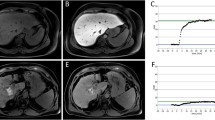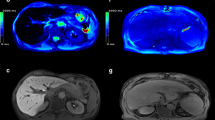Abstract
Objectives
To determine whether liver function as determined by intravenous administration of 13C-methacetin and continuous real-time breath analysis can be estimated quantitatively from gadoxetic acid (Gd-EOB-DTPA)-enhanced magnetic resonance (MR) relaxometry.
Methods
Sixty-six patients underwent a 13C-methacetin breath test (13C-MBT) for evaluation of liver function and Gd-EOB-DTPA-enhanced T1-relaxometry at 3 T. A transverse 3D VIBE sequence with an inline T1 calculation based on variable flip angles was acquired prior to (T1 pre) and 20 min post-Gd-EOB-DTPA (T1 post) administration. The reduction rate of T1 relaxation time (rrT1) and T1 relaxation velocity index (∆R1) between pre- and post-contrast images was evaluated. 13C-MBT values were correlated with T1post, ∆R1 and rrT1, providing an MRI-based estimated 13C-MBT value. The interobserver reliability was assessed by determining the intraclass correlation coefficient (ICC).
Results
Stratified by three different categories of 13C-MBT readouts, there was a constant increase of T1 post with increasing progression of diminished liver function (p ≤ 0.030) and a constant significant decrease of ∆R1 (p ≤ 0.025) and rrT1 (p < 0.018) with progression of liver damage as assessed by 13C-methacetin breath analysis. ICC for all T1 relaxation values and indices was excellent (> 0.88). A simple regression model showed a log-linear correlation of 13C-MBT values with T1post (r = 0.57; p < 0.001), ∆R1 (r = 0.59; p < 0.001) and rrT1 (r = 0.70; p < 0.001).
Conclusion
Liver function as determined using real-time 13C-methacetin breath analysis can be estimated quantitatively from Gd-EOB-DTPA-enhanced MR relaxometry.
Key Points
• Gd-EOB-DTPA-enhanced T1 relaxometry quantifies liver function
• Gd-EOB-DTPA-enhanced MR relaxometry may provide parameters for assessing liver function before surgery
• Gd-EOB-DTPA-enhanced MR relaxometry may be useful for monitoring liver disease progression
• Gd-EOB-DTPA-enhanced MR relaxometry has the potential to become a novel liver function index





Similar content being viewed by others
Abbreviations
- 13C-MBT:
-
13C-methacetin breath test
- Gd-EOB-DTPA :
-
Gadoxetic acid
- HCC:
-
Hepatocellular carcinoma
- CYP1A2:
-
Hepatocyte-specific cytochrome P450 1A2
- ICG:
-
Indocyanine green
- LiMAx:
-
Liver maximum capacity
- NASH:
-
Non-alcoholic steatohepatitis
- OATP:
-
Organic anion transporting peptide
- rrT1:
-
Reduction rate of T1 relaxation times
- ROI:
-
Region of interest
- SI:
-
Signal intensities
- ∆R1:
-
T1 relaxation velocity index
- T1 post:
-
T1-relaxometry measurements 20 min after Gd-EOB-DTPA administration
References
Morris-Stiff G, Gomez D, Prasad R (2009) Quantitative assessment of hepatic function and its relevance to the liver surgeon. J Gastrointest Surg 13:374–385
Guglielmi A, Ruzzenente A, Conci S, Valdegamberi A, Iacono C (2012) How much remnant is enough in liver resection? Dig Surg 29:6–17
Schreckenbach T, Liese J, Bechstein WO, Moench C (2012) Posthepatectomy liver failure. Dig Surg 29:79–85
Stockmann M, Lock JF, Riecke B et al (2009) Prediction of postoperative outcome after hepatectomy with a new bedside test for maximal liver function capacity. Ann Surg 250:119–125
Lock JF, Schwabauer E, Martus P et al (2010) Early diagnosis of primary nonfunction and indication for reoperation after liver transplantation. Liver Transpl 16:172–180
Lock JF, Westphal T, Rubin T et al (2017) LiMAx test improves diagnosis of chemotherapy-associated liver injury before resection of colorectal liver metastases. Ann Surg Oncol. https://doi.org/10.1245/s10434-017-5887-2
Kaffarnik MF, Lock JF, Vetter H et al (2013) Early diagnosis of sepsis-related hepatic dysfunction and its prognostic impact on survival: a prospective study with the LiMAx test. Critical Care (London, England) 17:R259
Rubin T, von Haimberger T, Helmke A, Heyne K (2011) Quantitative determination of metabolization dynamics by a real-time 13CO2 breath test. J Breath Res 5:027102
Jara M, Bednarsch J, Valle E et al (2015) Reliable assessment of liver function using LiMAx. J Surg Res 193:184–189
Stockmann M, Lock JF, Malinowski M, Niehues SM, Seehofer D, Neuhaus P (2010) The LiMAx test: a new liver function test for predicting postoperative outcome in liver surgery. HPB (Oxford) 12:139–146
Hamm B, Staks T, Muhler A et al (1995) Phase I clinical evaluation of Gd-EOB-DTPA as a hepatobiliary MR contrast agent: safety, pharmacokinetics, and MR imaging. Radiology 195:785–792
Nassif A, Jia J, Keiser M et al (2012) Visualization of hepatic uptake transporter function in healthy subjects by using gadoxetic acid-enhanced MR imaging. Radiology 264:741–750
Noren B, Forsgren MF, Dahlqvist Leinhard O et al (2013) Separation of advanced from mild hepatic fibrosis by quantification of the hepatobiliary uptake of Gd-EOB-DTPA. Eur Radiol 23:174–181
Kamimura K, Fukukura Y, Yoneyama T et al (2014) Quantitative evaluation of liver function with T1 relaxation time index on Gd-EOB-DTPA-enhanced MRI: comparison with signal intensity-based indices. J Magn Reson Imaging 40:884–889
Dahlqvist Leinhard O, Dahlstrom N, Kihlberg J et al (2012) Quantifying differences in hepatic uptake of the liver specific contrast agents Gd-EOB-DTPA and Gd-BOPTA: a pilot study. Eur Radiol 22:642–653
Kukuk GM, Schaefer SG, Fimmers R et al (2014) Hepatobiliary magnetic resonance imaging in patients with liver disease: correlation of liver enhancement with biochemical liver function tests. Eur Radiol 24:2482–2490
Katsube T, Okada M, Kumano S et al (2011) Estimation of liver function using T1 mapping on Gd-EOB-DTPA-enhanced magnetic resonance imaging. Investig Radiol 46:277–283
Seale MK, Catalano OA, Saini S, Hahn PF, Sahani DV (2009) Hepatobiliary-specific MR contrast agents: role in imaging the liver and biliary tree. Radiographics 29:1725–1748
Stockmann M, Lock JF, Malinowski M et al (2010) How to define initial poor graft function after liver transplantation? - a new functional definition by the LiMAx test. Transpl Int 23:1023–1032
Jara M, Reese T, Malinowski M et al (2015) Reductions in post-hepatectomy liver failure and related mortality after implementation of the LiMAx algorithm in preoperative work-up: a single-centre analysis of 1170 hepatectomies of one or more segments. HPB (Oxford) 17:651–658
Haimerl M, Verloh N, Zeman F et al (2013) Assessment of clinical signs of liver cirrhosis using T1 mapping on Gd-EOB-DTPA-enhanced 3T MRI. PLoS One 8:e85658
Heye T, Yang S-R, Bock M et al (2012) MR relaxometry of the liver: significant elevation of T1 relaxation time in patients with liver cirrhosis. Eur Radiol 22:1224–1232
Haimerl M, Verloh N, Fellner C et al (2014) MRI-based estimation of liver function: Gd-EOB-DTPA-enhanced T1 relaxometry of 3T vs. the MELD score. Sci Rep 4:5621
Yoneyama T, Fukukura Y, Kamimura K et al (2014) Efficacy of liver parenchymal enhancement and liver volume to standard liver volume ratio on Gd-EOB-DTPA-enhanced MRI for estimation of liver function. Eur Radiol 24:857–865
Haimerl M, Schlabeck M, Verloh N et al (2016) Volume-assisted estimation of liver function based on Gd-EOB-DTPA-enhanced MR relaxometry. Eur Radiol 26:1125–1133
Leonhardt M, Keiser M, Oswald S et al (2010) Hepatic uptake of the magnetic resonance imaging contrast agent Gd-EOB-DTPA: role of human organic anion transporters. Drug Metab Dispos 38:1024–1028
Graaf WD, Häusler S, Heger M et al (2011) Transporters involved in the hepatic uptake of (99m)Tc-mebrofenin and indocyanine green. J Hepatol 54:738–745
Armuzzi A, Candelli M, Zocco MA et al (2002) Breath testing for human liver function assessment. Aliment Pharmacol Ther 16:1977–1996
Afolabi P, Wright M, Wootton SA, Jackson AA (2013) Clinical utility of 13C-liver-function breath tests for assessment of hepatic function. Dig Dis Sci 58:33–41
Orlando R, Padrini R, Perazzi M, De Martin S, Piccoli P, Palatini P (2006) Liver dysfunction markedly decreases the inhibition of cytochrome P450 1A2-mediated theophylline metabolism by fluvoxamine. Clin Pharmacol Ther 79:489–499
Floreani M, De Martin S, Gabbia D et al (2013) Severe liver cirrhosis markedly reduces AhR-mediated induction of cytochrome P450 in rats by decreasing the transcription of target genes. PLoS One 8:e61983
Hasler JA (1999) Pharmacogenetics of cytochromes P450. Mol Asp Med 20(12-24):25–137
Elbekai RH, Korashy HM, El-Kadi AO (2004) The effect of liver cirrhosis on the regulation and expression of drug metabolizing enzymes. Curr Drug Metab 5:157–167
Morgan DJ, McLean AJ (1995) Clinical pharmacokinetic and pharmacodynamic considerations in patients with liver disease. An update. Clin Pharmacokinet 29:370–391
Kawasaki S, Imamura H, Bandai Y, Sanjo K, Idezuki Y (1992) Direct evidence for the intact hepatocyte theory in patients with liver cirrhosis. Gastroenterology 102:1351–1355
Huet PM, Villeneuve JP, Fenyves D (1997) Drug elimination in chronic liver diseases. J Hepatol 26(Suppl 2):63–72
Hickey PL, Angus PW, McLean AJ, Morgan DJ (1995) Oxygen supplementation restores theophylline clearance to normal in cirrhotic rats. Gastroenterology 108:1504–1509
Wang L, Collins C, Kelly EJ et al (2016) Transporter expression in liver tissue from subjects with alcoholic or hepatitis C cirrhosis quantified by targeted quantitative proteomics. Drug Metab Dispos 44:1752–1758
Funding
The authors state that this work has not received any funding.
Author information
Authors and Affiliations
Corresponding author
Ethics declarations
Guarantor
The scientific guarantor of this publication is PD Dr. Philipp Wiggermann.
Conflict of interest
The authors of this manuscript declare no relationships with any companies, whose products or services may be related to the subject matter of the article.
Statistics and biometry
One of the authors has significant statistical expertise.
No complex statistical methods were necessary for this paper.
Informed consent
Written informed consent was obtained from all subjects (patients) in this study.
Ethical approval
Institutional Review Board approval was obtained.
Methodology
• retrospective
• case-control study
• performed at one institution
Rights and permissions
About this article
Cite this article
Haimerl, M., Fuhrmann, I., Poelsterl, S. et al. Gd-EOB-DTPA-enhanced T1 relaxometry for assessment of liver function determined by real-time 13C-methacetin breath test. Eur Radiol 28, 3591–3600 (2018). https://doi.org/10.1007/s00330-018-5337-y
Received:
Revised:
Accepted:
Published:
Issue Date:
DOI: https://doi.org/10.1007/s00330-018-5337-y




